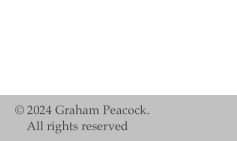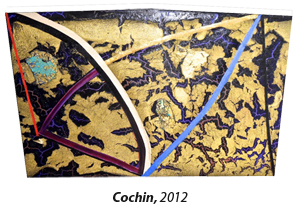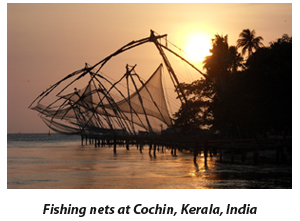 |
 |
|||||
The Geometric paintings, 2013In these new paintings I employ a more geometric shaping than in recent years. The main thrust of these geometrical works offers the potential for pronounced spatial illusions. These moments of transition when the work suggests a pathway for innovation are inspiring and create the excitement and energy for me to discover more. I have always been back and forth in my work between geometrically structured shapes as in my diamond shapes of the Early Crazing of the 1980’s, and the organic shaping interpreting the natural paint flow and imagery in the Colour and Dimensional paintings of the early 1990’s. The late 1990’s saw a simplification in the Circularity paintings. The Glitter Paintings and New New Illusionism works of the late 1990’s through the 2000’s saw simplified shapes also. In the NNI paintings more cut outs and painted illusions appear within the large scale crazing. In these new Geometric works the ‘crazing ‘, (my signature invention) is reintroduced with the smaller scale crazing of the 1980’s and the angular stretcher re-emerges. For the first time since the early 1970’s I am starting the painting by setting the shape before I pour paint. I add bands or stripes collaged on to accentuate and create, with the outside shape, spatial illusions. I create my poured crazing within these boundaries and over paint and change surface levels by padding, as I have since the 1990’s. I used geometric cropping in my work in the 1980’s to compose and tension the fields of crazing which had a tendency towards patterning. Now I am reversing this principle by creating the geometry before creating the painted crazed field. This concept comes from the observations I made last year while working on the India Suite (extra large) collages, where I was pouring in place large rectangular slabs. This approach, which was new, worked well and I liked the way the crazing related to the edge. I seized upon this way of painting, in pouring against a fixed edge, and I am exploring this approach in these new works. No matter what I compose, I respond to whatever occurs in the resulting pours during drying and when dry. I have considerable experience in what I can achieve, but the excitement in the way I paint is always that the crazing formations offer unique characteristics. No matter how much I plan, hypothesize and imagine the outcome of my pourings, they always offer an element of surprise. The vocabulary of surface manipulation that I have developed allows me the flexibility I need to unify whatever the work poses to be resolved. I paint in or out, editing the crazed formation, I use the unpainted edges, I infill with padding, I cut out, and collage, whatever is needed to resolve the works potential. I have no rules and rely on trial and error and my eye to judge what remains good. This geometrical transition began in 2008 but was not followed up on as I became involved in making collages and did not paint many canvases or finish those works. In the summer of 2010 I went to Denizli, Turkey to an artists workshop where I made a suite of lino prints in which I began to explore geometric contours. Most of 2011 and 2012 was spent on making collages so it is only now that I am returning fully to painting and pursuing this new direction. More to come. |
||||||
 |
||||||
 |
||||||